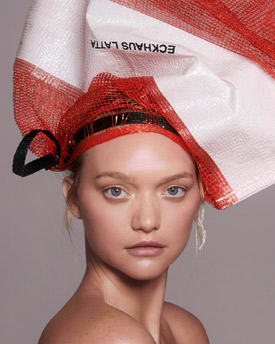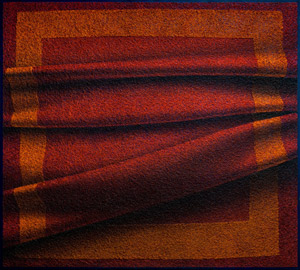Hanging by a Thread
John Haberin New York City
Eckhaus Latta, Antonio Santin, and Sutures
Tapestry, Painting, and Fashion
A light box leans casually against a pillar, near the lobby cafeteria, as if left there by mistake, but do not be fooled. At the size of a person, the photograph is begging for attention, and so is its sexy model.
She wears only a reddish orange and white tote bag, upside-down on her head. Is it art, fashion, or a not so subtle dig at art and fashion? To judge by its designer logo (upside-down, of course), Eckhaus Latta could be any or all of the above. Fashion has come to the Whitney, with a young label and a knowing wink.  The recovery of design for art has proceeded far enough that why not just go all out and put on a fashion show? For one thing, commercial aspirations can get in the way of irony and vice versa—but Antonio Santin and others can still take tapestries and their illusion as painting.
The recovery of design for art has proceeded far enough that why not just go all out and put on a fashion show? For one thing, commercial aspirations can get in the way of irony and vice versa—but Antonio Santin and others can still take tapestries and their illusion as painting.
Turning fashion upside-down
When the Met displays fashion, from the heyday of Versailles to the costliest of designer labels, it invites one to a gala—much like a private affair for trustees and donors. When MoMA does, it aims for a comprehensive picture of popular culture and a surfeit of pandering. (Its chief curator and director of MoMA PS1, Klaus Biesenbach, is heading for LA, where he belongs.) The Brooklyn Museum would rather stay in touch with a hipper borough, with David Bowie. The Whitney, to its credit, is late to the picture and promises to turn that, too, upside-down. It picks out two cool kids just over thirty, for their "experimental knitwear."
Whatever your attitude when it comes to style and experiment, Mike Eckhaus and Zoe Latta have you covered. Like the bag, they want to say just one word, plastics—and they mean to bring out the plasticity of fashion. They got the idea for a fashion label as students at the Rhode Island School of Design, where one was studying sculpture and the other textiles. RISD itself marks them as art-world fashion, with recent MFAs in photography and painting among other 2018 summer group shows in New York. Then, too, textiles as art have taken on a greater prominence, thanks to feminism, global cultures, and a revival of painting, with its manifold colors in the picture plane. They interrupt their tacky floral carpeting with threads coarse to the point of major surgery.
They also hit all the right museum notes, in what a show of craft at the Whitney calls "Making Knowing." Light boxes within the gallery have nonprofessional models and a multiracial cast. A woman looks trendy enough, in flowing brown hair and bold sunglasses, but a black man's straight blond hair drapes over his head like a yellow raincoat that I must have worn at age ten. His white jacket and pants, spotted red, appear torn from the same soiled sheet. Further inside, past a partition with fashionably exposed studs, the show opens onto a full-fledged store, touching and buying definitely permitted. Its populism extends to its t-shirts, white socks, faded denim, and the like by more than a dozen contributors.
The clothing uses recycled fabrics, for political correctness, or just plain trash, like Talia Levitt with her illusion of rags. They are also the site of text art and performance. As one item proclaims, it is "trying to organize the fantasy." So are still more amateur actors—not the models, but workers from the museum's lobby gift shop who staff the space, not to mention shoppers checking out each other's claims to style. Still further inside, past a plastic rope curtain, a room holds a still greater fantasy, in dozens of surveillance monitors and a window through which one may look out but not in. They put visitors to the dark chamber in the role of capitalism's gatekeepers and protectors.
You may relish the part if you have seen "Public, Private, Secret," "Everything Is Connected," and other art about the surveillance state. You may relish it, too, if you fell for Lauren Greenfield and her fascination with wealth and privilege. In a show called "Possessed," consumption is never far from obsession. Then again, you may wonder how a show can touch on so many subjects with so little insight into any of them. Fashion or art, Eckhaus Latta is still a business, and a t-shirt alone will set you back sixty dollars. On the monitors, the boutique looks more like a shopping mall.
Touching may be free, but the Whitney's lobby gallery is always free (a gesture to the community worth heeding). Now it has merely become an extension of the gift shop, where each item bears the label "Special Museum Exhibition Product." Christopher Y. Lew shares the role of curator with Lauri London Freedman, the museum's head of product development. Are they peddling innovative design or just the cachet of fine art and collectibles? Eckhaus and Latta may be questioning art and fashion, but with precisely one question: how do more celebrated labels stack up to them?
Suture yourself
Fabric has so entered the realm of fine art that Antonio Santin renders it in paint. Does that make it merely an illusion? Maybe not, no more than for Anni Albers, Lisa Alvarado, Christopher Myers, Dawn Williams Boyd, or Katarina Riesing, for his oils have a weave of their own. Santin, a Spaniard who lives and works in Brooklyn, relishes their color—from thin party colored stripes to deep red that will have anyone feeling a blanket's warmth. Light and shadow do not so much break across his surfaces as burst out from them. They are all the more tactile and colorful for appearing at life size.
Santin, in short, works in trompe l'oeil, to deceive the eye. As often in that tradition, he brings his subject right up to the picture plane to further the deception. The painted surface is a blanket, all the way across and all the way down. He also incorporates deep folds in his compositions, most often several to a frame, and at times the further illusion of paint splatters. They augment and compete with the parallel lines and curves of the patterns themselves. They also add to the illusion, to the point that he might be hanging actual woolens in the gallery.
He should have anyone hanging by a thread, but he is hardly alone. What not so very long ago was a radical assertion of "women's work" and craft in the face of fine art has become all but commonplace. It appeared with Charles LeDray at the Whitney in 2001 and again with tapestry from Africa in 2015. It colors El Anatsui and his tying together of caps from liquor bottles—or stuffed fabric on the High Line and in the galleries from Sheila Hicks.  It appeared in just the last months with Gee's Bend quilting at the Met and more recently with a Gee's Bend quilter, Mary Lee Bendolph. In a scarily efficient art market, outsider art and political protest enter the mainstream.
It appeared in just the last months with Gee's Bend quilting at the Met and more recently with a Gee's Bend quilter, Mary Lee Bendolph. In a scarily efficient art market, outsider art and political protest enter the mainstream.
Could that be a good thing? I should hope so, for all my unease, but it may have already become a cliché, and Santin is here to turn it, too, upside-down. If hangings risk becoming a quick way raising prices at the very expense of women and outsiders, he breaks with using fabric as a medium of painterly expression. Indeed, he reverses the formula, with paint as the medium and fabric as the ambiguous message. Two concurrent shows at his gallery break with it as well. Upstairs, Jong Oh works in single threads strung partway or all the way between floor and ceiling, like Richard Tuttle. Rather than seek a plane of color, however, he dares one to spot the work at all—and then to dispel its appearance as a solid.
On the floor between, a group show further maps the possibilities that current practices often overlook. "Sutures" takes its name from a vertical assembly of large spools by Louise Bourgeois, like an overly elaborate lamppost. It includes a near downpour of color in felt and zippers on wire by Lisa Hoke, as When the Rains Came, and a large open grid only occasionally woven together by Michele Ciacciofera. It includes, too, beaded ropes snaking out from a box, by Maria Nepomuceno, and an equally threatening cocoon of silk and acrylic by Julia von Eichel. Elaine Reichek uses embroidery to recreate book pages, like Hollis Sigler, as a sampler with feminist intent. As the show's title suggests, the work barely holds together—and a good thing, too.
Embroidery may still mean blankets, like quasi-paintings of thicker threads by Amanda Valdez and evocations of nineteenth-century industrial looms by Ellen Lesperance. (Lesperance also appeared recently in "Trigger" at the New Museum for other aspects of art and gender.) Does that relegate Santin to the realm of illusion? Perhaps, but his paint has a physical weave as well—thick, coarse, and difficult to penetrate. He applies his thousands of thin curves of color with anything from a fine brush to a syringe. It, too, is a tapestry, both metaphoric and real. A man may appropriate it for his own ends, but the medium has the last word.

Eckhaus Latta ran at The Whitney Museum of American Art through October 8, 2018, Antonio Santin and "Sutures" at Marc Straus through October 16, Amanda Valdez at Denny through October 14, and Ellen Lesperance at Derek Eller, through October 7. As the links here make clear, this is now at least my third full-length rundown of fabrics in fine art.




